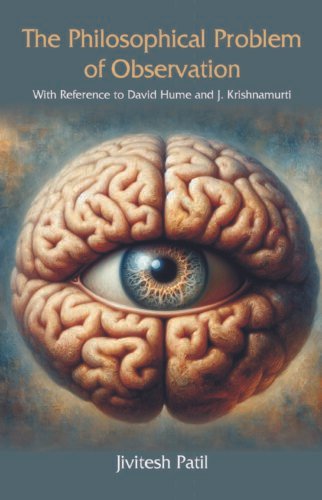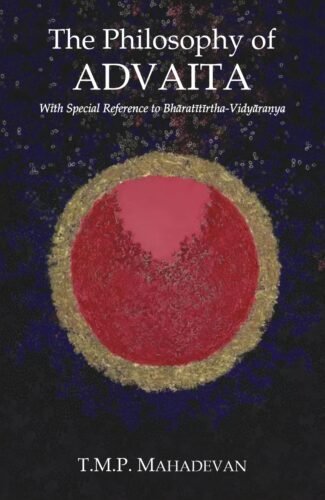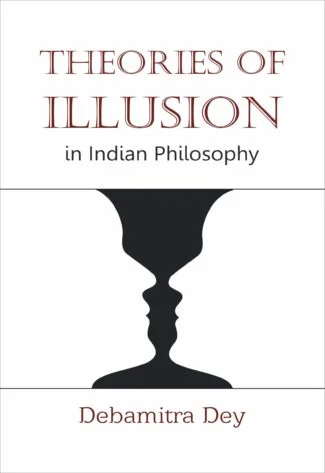Showing 61–72 of 80 results

It talks about the contrasting philosophies of J. Krishnamurti and David Hume navigating the convergence of their thoughts on the observer’s role in the process of observation. In so doing, it delves into the world of philosophy of mind as it spans ancient to modern times.
“The Philosophical Problem of Observation with Reference to David Hume and J. Krishnamurti offers a sophisticated exploration of the intricate relationship between perception, the self and the observer. Engaging with the empiricism of David Hume and the meditative insights of J. Krishnamurti, the book delves into fundamental questions about the nature of observation, its role in shaping human understanding, and its implications for knowledge and consciousness. Dr Patil critically examines Hume’s dissection of perception and belief alongside Krishnamurti’s radical proposition of observation without an observer, illuminating their shared rejection of a permanent self. By bridging distinct philosophical traditions, this book investigates the transformative potential of a pure, unconditioned state of perception and challenges entrenched notions of cognition and the self.
Addressing key questions such as the influence of memory and belief on perception and the unity of the observer and the observed, the book presents a compelling dialogue between philosophical inquiry and practical introspection. It weaves philosophy, psychology, and consciousness studies into an interdisciplinary framework for achieving clarity into the question of self and observation. This thought-provoking work is an essential read for scholars of philosophy and cognitive science, as well as seekers of deeper understanding. With its innovative insights, it offers a roadmap for navigating the philosophical dimensions of perception and unlocking the transformative aspect of observation.”

The book is an attempt to present systematically the philosophy of Advaita as expounded by BhÀratÁtÁrtha-VidyÀraõya, an outstanding figure in the History of Advaita after Œaôkara, and to assess the contribution of that great scholar-saint to the Vivaraõa school in particular and to Advaita metaphysics in general.
“This volume presents the Advaita philosophy with special reference to the teaching of BhÀratÁtÁrtha-VidyÀraõya. BhÀratÁtÁrtha is an outstanding name in the history of Advaita after Œaôkara. The volume of Advaita literature has grown enormously in the post-Œaôkara period, necessitated by charges and countercharges. Amidst numerous such works, VidyÀraõya develops his Advaita position in a striking way.
While dealing with all the quintessential concepts of Advaita philosophy, the book is an attempt to present systematically the philosophy of Advaita as expounded by BhÀratÁtÁrtha-VidyÀraõya and to assess the contribution of that great scholar-saint to the Vivaraõa school in particular and to Advaita metaphysics in general. It thus encompasses all major topics of Advaita such as its epistemological position including six pramÀõas, truth and error, reality as existence and bliss, the concepts of witness-Self, MÀyÀ, path to perfection and release.
The present treatise would thus help students of Indian philosophy in getting to know the main concepts of Advaita doctrine vis-à-vis other philosophical systems of India, making it a must need collection, enabling them widen their horizon of knowledge.
“

This book discusses the quintessential aspects of George Santayana’s wide and comprehensive philosophy. Its critical and comparative discussions have taken place centring round the problems of Epistemology, Metaphysics, Aesthetics, Ethics and Religion, thereby making it all the more interesting.
This book discusses the quintessential aspects of George Santayana’s wide and comprehensive philosophy. Its critical and comparative discussions centre round the problems of Epistemology, Metaphysics, Aesthetics, Ethics and Religion. This makes it all the more interesting.
What is noteworthy about this book is that it shows how naturalism serves as a basis of the idealistic philosophy of George Santayana. Moreover, the illustrious part of this treatise is that essence, as discovered by Santayana by the doubting process, serves as the keynote of his whole philosophy.
The exposition of Santayana’s philosophy on the basis of the above two points is an outstanding feature of the present work. What is captivating about this book is that it shows how the natural gets reconciled with the ideal by making the former the ground of the latter.

The book addresses the main theme of the nature of consciousness from a wide-ranging stances and have also taken a step towards establishing a platform for an intense and critical study of Indian theories of consciousness
The book provides a platform to discuss and examine the subtle and complex issues related to the nature of consciousness, self, mental states and subjectivity from Indian and cross-cultural perspectives. It explores contemporary problems of consciousness and tries to find solutions from Indian philosophical traditions. The purpose is to understand how far the views and approaches of classical and contemporary Indian thinkers are relevant in contemporary consciousness studies. The book argues that great thinkers of Vedānta, Tantra, Sāṁkhya and Buddhism have done enormous works which can be explored, examined and enhanced even today for a better comprehension of the subjectivity and conscious experience.
The chapters of this present volume have thoroughly explored and examined many classical Indian theories of consciousness. Keeping in view the objectives of this volume, the contributors have made an effective effort to reflect critically on Indian theories to answer the contemporary problems. There are chapters discussing and examining the standpoints of Indian thinkers like Abhinavagupta, Utpala, Śaṅkara, Rāmānuja, Swāmī Vidyāraṇya, Nāgārjuna, Gautama and many more. On the other hand, there are chapters engaged in reappraising the philosophical positions of Kant, Hegel, Sartre, Chalmers, Searle, Dennett and other contemporary thinkers. The chapters of this volume have addressed the main theme from a wide-ranging stances and have also taken a step towards establishing a platform for an intense and critical study of Indian theories of consciousness.
The book is extremely beneficial for students and scholars interested in classical Indian philosophy and contemporary consciousness studies. It inspires more researchers to ponder upon the concept of consciousness and subjectivity from multiple dimensions.

This volume presents the translation and interpretation of thirteen principal Upanisads such as Brhadaranyaka, Chandogya, Taittiriya, Aitareya, Kausitaki, Kena, Katha, Isa, Mundaka, Prasna, Mandukya, Svetasvatara and Maitri along with the outline of the philosophical wisdom inherent in these Upanisads. It also features the recurrent and parallel passages in these principal Upanisads and the Bhagavadgita.
Upanisads are an authoritative compendium of Indian metaphysics. They represent the earnest efforts of profound thinkers of early India to solve the problems of origin, nature, and destiny of man and the universe, more technically the meaning and value of knowing and being. They are replete with sublime conceptions and with intuitions of universal truth. These Upanisads sets forth two opposing theories: one of mundane life and the other relating to a life that is in search of the Supreme Reality and man’s ultimate aim.
Though, traditionally, 108 Upanisads are well known and subject to various studies, there are around 200 Upanisads in toto. Of them, this volume contains the translation and interpretation of thirteen principal Upanisads such as Brhadaranyaka, Chandogya, Taittiriya, Aitareya, Kausitaki, Kena, Katha, Isa, Mundaka, Prasna, Mandukya, Svetasvatara and Maitri along with the outline of the philosophical wisdom inherent in these Upanisads. It also features the recurrent and parallel passages in these principal Upanisads and the Bhagavadgita.

It vividly and graphically presents the key concepts of the Bhagavadgita while majorly discussing the concepts like atman, Paramatman, jagat, karma-yoga, jnana-yoga, bhakti-yoga, dhyana-yoga, sthitaprajna, sadhakas’ challenges and the ways out.
This volume covers all the aspects of Yoga and self-management discussed in the Bhagavadgita –– a comprehensive text of personal and professional life management and adhyatma-sadhana (spiritual upgradation). What makes the book special is its dialogue format between a guru and his disciple as exactly what we witness in the Bhagavadgita as between Sri Krsna and Arjuna.
It vividly and graphically presents the key concepts of the Bhagavadgita while majorly discussing the concepts like karma-yoga, jnana-yoga, bhakti-yoga, dhyana-yoga, sthitaprajna, and seven keys of self upgradation, which leads towards Health, Happiness and Harmony, challenges and the ways out.
This book will help in the making broader understanding of the concepts and philosophy of the Bhagavadgita, which transcends time and space, to register with the new generation readers and thereby emulate and practise the varied forms of Yoga.

This volume extensively deals with the concept of false cognition, or illusion, and analyses how the Samkhya-Yoga, Buddhist, Nyaya, Mimamsa and Vedanta schools of thought have criticized their opponents to establish their own view from the metaphysical and epistemological standpoints on illusion, along with many more minor theories.
Every school of Indian philosophy has prescribed its own ways to obliterate human sufferings in the best possible manner. More or less each of them has pointed out that the root cause of sufferings is false cognition of human being about the world and its objects. Only true cognition can eliminate the false one and like the destruction of a series in a chain, the sufferings will be automatically demolished at a point of time. Hence it is necessary to know the nature as well as the characteristics of false cognition.
The term illusion is used to denote false cognition according to Indian philosophy. So it may or may not have similarities with the views of Western thought. Each major school of Indian philosophy has analysed the theory of illusion from its metaphysical as well as epistemological standpoint. As a result, major theories Samkhya-Yoga, Buddhist, Nyaya, Mimamsa and Vedanta regarding illusion (popularly known as Khyativada) and many more minor theories have originated.
This volume thus extensively analyses how these schools have criticized their opponents standpoint to establish their own view, making it an interesting reading for everyone, be it a general reader, a student or a scholar in a simple and easy to understand format and language.
Thinker, Thought and Knowledge critically and analytically reasons that some of the philosophical expositions like “thought has created the thinker” and “higher-order thoughts are themselves conscious” hinder us from explaining our sense of unity of consciousness. This book presents and elucidates some observations — thought cannot create thinker; along with thinker and thought, thinking too is quintessential for individual experience to take place; thinker, thinking and thought are fundamentally one in self-consciousness; thought becomes the object of self-consciousness; and the modern science attempts to undermine the principle of causation — from the East—West perspective, and registers its disproval with the philosophical views of scholars like J. Krishnamurti and a few other modern philosophers. Coming to the knowledge aspect, the volume delineates the relative existence and knowledge dealing with the absolute reality, and discusses it on the basis of Advaita Vedanta and the Yogacara Vijiianavada of the Buddhist philosophy along with Immanuel Kant’s theory of knowledge. The researcher’s approach employed in this volume should help the students of philosophy and other discerning readers take an analytical and critical positioning towards many a philosophical problem that they come across.
The Bṛhadāraṇyaka Upaniṣad is the earliest text in its genre, inaugurating the entire history of Indian philosophy. Commented on by numerous teachers of Vedantic schools, its fertility is not exhausted by any or all of them. Unlike later philosophy, it is not a work of explanation but of contemplative praxis towards cosmic and nondual self-realization. Locating it in a countercultural movement and relating it to the ontological vision of Sri Aurobindo, Time-Steps of the Cosmic Horse is a sustained contemplation on the first chapter of this Upaniṣad drawing attention to the phenomenology and rhetorical structure of its linguistic action.
Towards a New Age of Nonviolence is a compilation of scholarly articles on Gandhi – his philosophy of nonviolence (ahimsa) and nonviolent action (satyagraha) – are the themes encompassing the volume. In a materialistic world of today, people hold guns and grudges, and for the slightest glitch, they pronounce wars that do not end. The fearful consequence of this would lead to human extinction very soon. In such a detrimental and precarious scenario, the only way out is to embrace the Gandhian way of living.
The book comprises 14 articles on Gandhi and his values, its relevance to industrial age, views on nonviolence, economics of gram swaraj, significance of peace and tolerance in an era of explosive technology and his spiritual and ethical doctrine in the context of current global conflicts. The book is sure, a must read for everyone who wants to see a better world.

The book presents the notion of unity in diversity in the context of globalization and multiculturalism. The concepts of unity and diversity have been contested in classical and modern theories. These theories give rise to the concept of diversity but jointly somehow they emerge as unity in diversity.
The book presents the notion of unity in diversity in the context of globalization and multiculturalism. Philosophically speaking, the concepts of unity and diversity have been contested in classical and modern theories; for instance, Plato’s idea of harmony and goodness, Aristotle’s phronesis or practical wisdom (teleology), Kant’s categorical imperative (deontology), and Mill’s utilitarianism (consequentialism) on the one hand and purusarthas divided into abhyudaya and nihsreyas, etc. on the other. These theories give rise to the concept of diversity but jointly somehow they emerge as unity in diversity.
In the era of globalization and multiculturalism, teleology, deontology, consequentialism and so on have been described, critiqued and even appreciated and appropriated from pluralistic perspective. With globalization and multiculturalism, human life is affected not only insofar as market is concerned, but also the ethnical, cultural and linguistic identities are equally affected. However, unlike globalization, multiculturalism endorses the role of the State in protecting and safeguarding the rights of diverse cultural groups, values and practices, marriage and settlements, property and inheritance, etc. so that members of each cultural community should become the valid participants in the civil and democratic life in the globalized world.
The perspectives of, and the conflict between individual needs and rights, and group needs and rights, have been conceptualized under liberalism and communitarianism. It is proposed to be achieved by developing cultural transformations in the era of globalization, thus creating reasonable exclusion on broader values. The effort is to allow these values to inform and reinforce each other for the possible foundations of multiculturalism, specially cosmopolitanism in the globalized world.
Vedanta for the Western World is a collection of sixty-eight articles appeared in a magazine having the same title during 1938-45 by eminent scholars of international repute such as Aldous Huxley, Allan Hunter, Gerald Heard and Swami Prabhavananda reflecting on the varied aspects and universal reflections of Vedanta, with an Introduction by Christopher Isherwood. Vedanta, the Vedic philosophy per se, and not time-specific, focuses on three fundamental propositions that man’s real nature is divine; aim of human life is to realize this divine nature; and all religions are essentially in agreement as far as this divine concept is concerned. The essays featured in this volume imbibe and exude the same philosophy being best suited to the understanding of new generation audience, especially the one that belongs to the Western world. This unique volume stands out in its genera of works due to a wide gamut of topics featured in it under the umbrella banner Vedanta. It enables every student of Vedanta know the essence of the Vedic philosophies from the perspectives of both Indian and Western scholars and men of merit.
| There are no products |